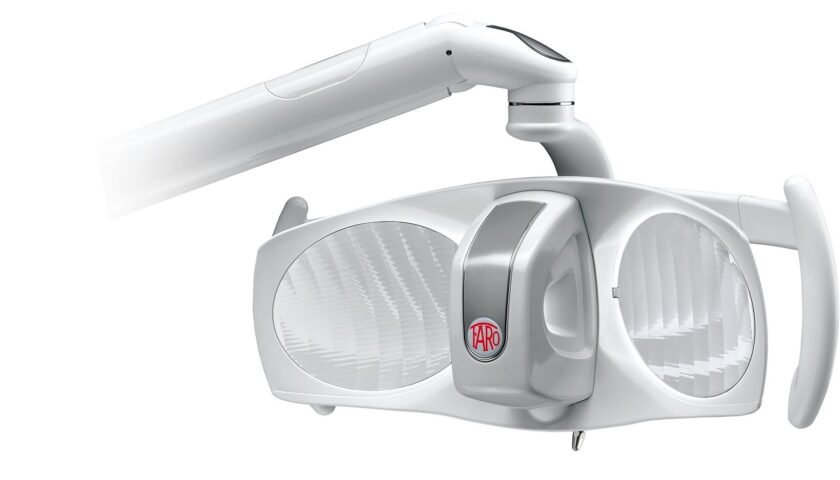The oral cavity is a dark and secluded field. Because of this, the operatory light is a crucial part of the daily armamentarium for every dentist and hygienist. Better visibility means better treatment for the patient. While halogen lights have been popular historically, newer LED technology is making its way into the field, providing brighter, more functional lighting for your treatment room.
Traditional light bulbs: In a normal light bulb, there is a circuit separated by a filament made from tungsten. The bulb is also filled with an inert gas to avoid contact with oxygen. As electric current is applied, electrons bump into atoms of the filament, exciting the atom to a higher energy state. As the atom falls back to a normal energy state, it releases the energy in the form of a photon. A side effect of this process is slow degradation of the tungsten, as well as generation of heat.
Halogen lighting: A halogen bulb also uses a tungsten filament, but is inside a quartz casing. In this case, the gas inside is a halogen such as fluorine or chlorine. The halogen gases help preserve the tungsten filament, and allow more electricity to be pushed through the bulb for greater brightness. A side effect of this, however, is greater generation of heat. Because of this, most operatory lights have a dichroic reflector, which allows reflection of light, but not heat.
LED Lighting: Light Emitting Diode—more commonly known as LED—lights are unique in that they have no filament. There is a block of material that efficiently conducts electricity, such as a mix of aluminum, gallium and arsenide. The light is created via the same basic principle in which electrons are excited and release photons. The released energy of the photon determines the wavelength of the light. A high energy fall will result in a short wavelength of light toward the UV spectrum. A low energy fall will result in a longer wavelength of light toward the infrared spectrum. White LEDs consist of a die that emits a blue light, but has a phosphor coating. A portion of the blue light is absorbed by the coating, and re-emitted at a lower energy and longer wavelength. Rather than a single wavelength, this results in a light that more broadly covers the colors of the rainbow.
Benefits of LED lights compared to Halogen:
- No filament to break down
- Less Heat
- Less energy needed because less energy is lost as heat
- Brighter per watt of energy applied
- Life span for the average LED is over 50,000 hours
What I Need to Know
Reflective Vs. Direct – Because halogen lights have a single light source, a reflector is used to focus the light. LED lights often are built in an array, allowing each one to be focused on a particular point.
Mounting Options – Consider the setup of your treatment rooms and what options are available for attaching the light. Options might include mounting the light to the patient chair, on the ceiling or on a nearby wall.
Position of the Controls – The controls of the light should be in easy reach without having to move your position in your chair. You shouldn’t have to stand to turn the light on or off. Consider options that allow the light to be controlled from the touchpad or chair controls as well.
Light Pattern – The light pattern should be crisp and concise. If there is not a defined edge, you may end up having too much light in the patients’ eyes rather than having a light focused on the oral cavity.
Brightness Settings – This is also known as illuminance. The light should have variable settings for brightness depending on the type of procedure you are performing, or in consideration of patient comfort.
Color Temperature – Most halogen lights have a broad spectrum of the rainbow from their light source, but are sometimes skewed toward a warmer color temperature. LED lights can be balanced to a color temperature similar to daylight, but may not include the entire spectrum of visible light. A color temperature closer to daylight reduces eye strain and is superior for shade matching.
Cure Safe Setting – Completely absent from halogen lights, LED operatory lights should have a cure safe setting that emits light without any blue wavelength. This allows you to keep the light on during bonding procedures such as anterior composites or when cementing veneers.
Infection Control – The light should be easy to clean, and make it easy to apply a barrier.
Questions to Ask
- Is this light compatible with my existing chair setup?
- What mounting options do I have available to me?
- What is the warranty on the light?
- Does it have variable brightness levels?
- Is there a cure safe mode?
- For LED operatory lights, what is the color temperature of the light?
Definitions :
Dichroic Reflector – A coating on the reflector of a halogen light that allows visible light to be reflected back while allowing infrared light (heat) to pass through.
Color Temperature – Sunlight is considered to have all colors of the rainbow, and has a neutral color temperature of 5000 K. A light with more orange or red is said to have a warmer color temperature, and will have a lower number. A light with more blue is said to have a cooler color temperature, and will have a higher number.
Color Rendering Index – A measure of how well the colors appear on the subject from a given light source. Basically, how well the operatory lights the oral cavity and shows its true color.
Illuminance – The amount of light hitting a surface area, essentially a measure of brightness.

